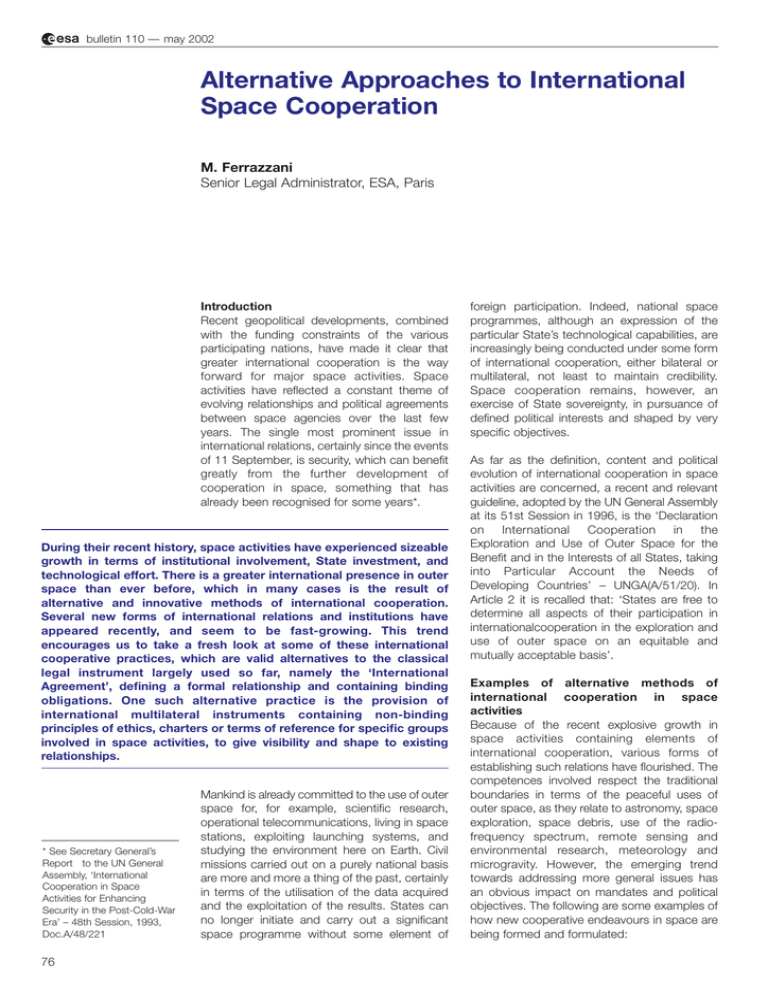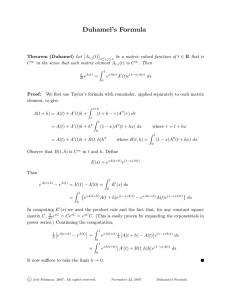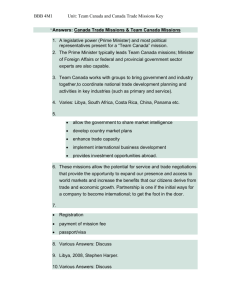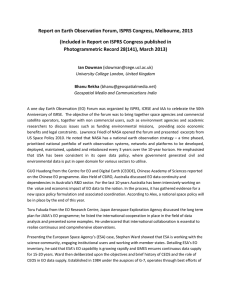Alternative Approaches to International Space Cooperation s M. Ferrazzani
advertisement

s bulletin 110 — may 2002 Alternative Approaches to International Space Cooperation M. Ferrazzani Senior Legal Administrator, ESA, Paris Introduction Recent geopolitical developments, combined with the funding constraints of the various participating nations, have made it clear that greater international cooperation is the way forward for major space activities. Space activities have reflected a constant theme of evolving relationships and political agreements between space agencies over the last few years. The single most prominent issue in international relations, certainly since the events of 11 September, is security, which can benefit greatly from the further development of cooperation in space, something that has already been recognised for some years*. During their recent history, space activities have experienced sizeable growth in terms of institutional involvement, State investment, and technological effort. There is a greater international presence in outer space than ever before, which in many cases is the result of alternative and innovative methods of international cooperation. Several new forms of international relations and institutions have appeared recently, and seem to be fast-growing. This trend encourages us to take a fresh look at some of these international cooperative practices, which are valid alternatives to the classical legal instrument largely used so far, namely the ‘International Agreement’, defining a formal relationship and containing binding obligations. One such alternative practice is the provision of international multilateral instruments containing non-binding principles of ethics, charters or terms of reference for specific groups involved in space activities, to give visibility and shape to existing relationships. * See Secretary General’s Report to the UN General Assembly, ‘International Cooperation in Space Activities for Enhancing Security in the Post-Cold-War Era’ – 48th Session, 1993, Doc.A/48/221 76 Mankind is already committed to the use of outer space for, for example, scientific research, operational telecommunications, living in space stations, exploiting launching systems, and studying the environment here on Earth. Civil missions carried out on a purely national basis are more and more a thing of the past, certainly in terms of the utilisation of the data acquired and the exploitation of the results. States can no longer initiate and carry out a significant space programme without some element of foreign participation. Indeed, national space programmes, although an expression of the particular State’s technological capabilities, are increasingly being conducted under some form of international cooperation, either bilateral or multilateral, not least to maintain credibility. Space cooperation remains, however, an exercise of State sovereignty, in pursuance of defined political interests and shaped by very specific objectives. As far as the definition, content and political evolution of international cooperation in space activities are concerned, a recent and relevant guideline, adopted by the UN General Assembly at its 51st Session in 1996, is the ‘Declaration on International Cooperation in the Exploration and Use of Outer Space for the Benefit and in the Interests of all States, taking into Particular Account the Needs of Developing Countries’ – UNGA(A/51/20). In Article 2 it is recalled that: ‘States are free to determine all aspects of their participation in internationalcooperation in the exploration and use of outer space on an equitable and mutually acceptable basis’. Examples of alternative methods of international cooperation in space activities Because of the recent explosive growth in space activities containing elements of international cooperation, various forms of establishing such relations have flourished. The competences involved respect the traditional boundaries in terms of the peaceful uses of outer space, as they relate to astronomy, space exploration, space debris, use of the radiofrequency spectrum, remote sensing and environmental research, meteorology and microgravity. However, the emerging trend towards addressing more general issues has an obvious impact on mandates and political objectives. The following are some examples of how new cooperative endeavours in space are being formed and formulated: alternative approaches to international space cooperation S PA C E F R E Q U E N C Y COORDINATION GROUP SFCG: Space Frequency Coordination Group The SFCG was created in 1980 as an ESA initiative to coordinate official government positions on frequency matters to be discussed at ITU and ruling conferences such as WARCs. The Terms of Reference for the Group have been accepted by all participating agencies. Almost all are space agencies or government space offices, which have some interest in using space frequencies. There are several Observers, among them the Radiocommunication Bureau of the ITU. The Group has successfully conducted coordination and applied a common policy approach through its annual meetings since 1980, on the basis of a rotating chairmanship. There is a permanent Secretariat (provided by ESA) and it issues Decisions, Resolutions or Recommendations covering the objectives and functioning of the Group. Under a ‘less formal and more flexible environment compared with the official organs of the ITU’, representatives define common positions for frequency allocations. Members coherently follow its work and Resolutions and the joint working produces smooth and effective international coordination for frequency allocation and use. IACG: Inter-Agency Consultative Group for Space Science The IACG was created in 1981 by four member agencies to maximise the opportunities for coordinating multilateral space-science missions recognised as being of common interest. The present members are ESA, Rosaviacosmos of Russia, ISAS of Japan, and NASA of the USA (for the history of the Group, see ESA Bulletin No. 51). The IACG provides an international forum in which space-science activities are reported by member agencies and proposals are elaborated for possible future collaborations at different levels. Since 1981, the IACG has been responsible for the coordination and common planning of several space-science missions and is considered a successful model for other disciplines. CEOS: Committee on Earth-Observation Satellites CEOS was created in 1984 following a recommendation expressed at the G-7 Economic Summit, on the initiative of US Government representatives inviting other governmental organisations to contribute to international cooperation on space-borne Earth-observation systems. The CEOS Terms of Reference were first adopted on 25 September 1984 in Washington DC, and have since been amended several times by consensus of the members. The Committee has achieved wide participation by interested government representatives and has become a major reference forum for the exchange of information and the issuing of recommendations regarding current and future remote-sensing programmes. The CEOS Plenary session approves Resolutions establishing definitions and policy principles widely recognised in the space community. It has created several Working Groups to address specific topics. Its technical standards, procedures and practices for accessing Earth-observation data are strongly followed for the great majority of the Earth-observing missions and have proved essential for successful international cooperation. IPOMS: International Polar Orbiting Meteorological Satellites Group IPOMS was created in 1983 under the auspices of a G-7 Economic Summit, with the scope of fostering exchanges and new initiatives for polar-orbiting meteorological satellites to be built and operated by others besides the US Government. The group served as an information-exchange forum for governments and space agencies, until its scope was embodied in that of CEOS. CGMS: Coordination Group on Geosynchronous Meteorological Satellites CGMS was established by the governments and international organisations either managing or having an interest in geostationary satellites for meteorological applications. For over 20 years, the Group has served as the focal point for this application and has reflected fairly the setting up and updating of international standards for meteorological data, which are uniformly and consistently applied by practically all governments. IGOS (International Global Observing Strategy) Partnership The IGOS group was created as a result of an informal meeting held in Paris in 1998 between representatives of international governmental programmes studying the environment, named 77 s bulletin 110 — may 2002 as ‘partners’. Their aims are to provide a comprehensive international framework in which to harmonise long-term strategies, and to coordinate resources devoted to conducting observations, either space-based or in-situ. A document ‘constituting an authoritative statement on the procedures for the IGOS partnership’, contains structures and procedures for proposing and agreeing common themes and activities. The partners, who hold regular meetings and publish their conclusions, which constitute a reference to harmonise the work of Earth-observation missions, maintain an active Secretariat. IADC: Inter-Agency Space Debris Coordination Committee The IADC’s terms of reference were approved in October 1993 and updated in March 1995, by countries and national or international space organisations that are carrying out space activities, either through manufacturing, launching and operating spacecraft, or manufacturing and launching rockets. Members are: DRA (UK), CNES (France), CNSA (China), ESA (Europe), ISRO (India), NASDA (Japan), NASA (USA), and RA (Russian Federation). Each is represented both on the Steering Committee and in the Working Groups. The purpose is to exchange information for cooperation purposes on space-debris issues, to identify debris-mitigation actions, and to recommend possible international norms. It provides the only informal opportunity at international level for regular debates about space-debris issues, which are now high on the agenda of the UN Committee for the Peaceful Uses of Outer Space (COPUOS). International Space Life Science Strategic Planning Working Group A Charter was adopted on 15 March 1980 by space agencies having significant programmes in the life sciences. Like the IACG, the Group has already served for a long time as an international forum for planning scientific experiments and possible cooperative endeavours. Its participants consider it a success, as its working results are the de facto guide for the future plans of each member agency when deciding on and funding lifescience activities. 78 SAF: Space Agency Forum The SAF was created in Rome on 23 April 1993 by government representatives of countries conducting space activities, with the intention of having a forum for exchanging views, following the positive experience with its predecessor SAFISY set up for the International Space Year (ISY) in 1992. For practical reasons, it is convened alongside the annual Congress of the International Astronautical Federation (IAF) and the chair rotates annually. It is considered a very useful forum, especially by those with medium-sized and small space programmes, for establishing international relations and coordination. A major declared objective of the SAF is cost-effective international cooperation between space agencies. ESCAP Region: Committee on the Asian Remote Sensing Programme This Committee was created by some government members of the UN Economic and Social Commission for Asia and the Pacific (ESCAP). Initially, the Governments of China, Indonesia, Malaysia, Nepal, the Philippines, Singapore, Sri Lanka and Thailand adopted the Terms of Reference of an Intergovernmental Consultative Committee on the Regional Remote Sensing Programme in Jakarta on 26 May 1984, providing for decision by consensus, or even by majority, of the members present and voting. Since then several sessions have been held and an active regional remotesensing programme has been created. APC-MCSTA: Asia-Pacific Conference on Multilateral Cooperation in Space APC-MCSTA is a recent and interesting effort to create a new form of regional cooperation for space missions, following the success in Asia of the ESCAP regional remote-sensing programme. The Asia-Pacific Conference adopted by consensus at its Plenary session recommendations creating a Liaison Committee that is explicitly mandated to play an institutional role between the parties involved. The scope of its activities includes the promotion of multilateral cooperation projects. Indeed, beyond the traditional space-faring nations, Asia is living proof of developing countries entering the space business and contributing to the future growth potential for space cooperation. The ASEAN group of countries could serve as a political example for organising space cooperation among emerging space countries. International Charter on Space and Major Disasters On 20 June 2000, a ‘Charter on cooperation to achieve the coordinated use of space facilities in the event of natural or technological disasters’ was signed by its founding members. alternative approaches to international space cooperation The goal is to promote cooperation between space agencies and space-system operators in the use of space facilities as a contribution to the management of crises arising from natural or technological disasters. It brings together space agencies having significant remotesensing activities that may be readily deployed in the event of a crisis. It also sets up a common mechanism for supplying, during a period of crisis, all available space data and facilities to States or communities whose population, activities or property are at risk. The present members are ESA, CNES, the Canadian Space Agency (CSA) and the Indian Space Research Organization (ISRO). Without becoming members, other entities may be called to be cooperating or associated bodies to contribute to the coordination mechanism, or else be a beneficiary body to receive data, associated information and services. Common issues associated with alternative methods In addition to the above bodies, there are many more examples of committees, working groups or academic relationships created by virtue of technical cooperation arrangements. There are many such schemes covering institutional relations for space activities, either bilateral or multilateral, sometimes with substantial decisionmaking authority delegated to ad-hoc bodies. In the space-relations arena, there is also a growing range of somewhat informal mutual institutions able to put forward the views of and to act for and represent the positions of the participating States. Members work in close collaboration, comfortable in the fact they still maintain a distinct identity but have wellcoordinated access to shared data and results to be utilised for the maximum benefit of all 79 s bulletin 110 — may 2002 participants. For many countries, these organisations are the only means for defining and implementing their space-cooperation links. Coordination mechanisms work on the declared basis of no exchange of funds and no transfer of technology. A good demonstration of the seriousness of benefit-sharing circle is provided by the fact that a non-participant who wishes to access the pooled results has to apply to join the Charter, to be accepted by general consensus of the members, and to bring a worthwhile contribution. States representatives meet regularly, convened with the declared intention of formulating and following the ground rules that they have established for themselves. The results of space missions, which often require vast investments, are freely exchanged between the participants for the purposes determined in the founding act. Reports of all these activities are openly published and often made available also to non-participants. Several of the above-mentioned groups make their proceedings and acts public via dedicated web sites. Such practices are founded on the recognised need for greater cooperation and flexible methods of coordination. However, such coordination between actors, whether ‘technical only’ or ‘purely scientific’, still establishes far-reaching relationships and practices, which in themselves constitute an alternative form of international space cooperation. Whether created for reasons of scientific progress or for the general exchange of information, the legitimacy, stability and success of these relationships endows them with both political and economic importance. Today the scientific and space community, in practising such international cooperation, is becoming more and more receptive to the common values and working methods contained in these charters. The more effective the informal character and behaviour agreed by the parties proves to be, the more this practice becomes recognised as perfectly and politically authoritative. This is where the border begins to blur between the classical binding agreements and the newer, less formal alternatives. General political statements in the founding charters and acts indicating that participation in activities is not considered binding upon governments, indicate how these methods are helping government representatives to access international space cooperation, in a manner that is flexible in form but still powerful in terms of achievable results. 80 Conclusions This article has hopefully provided a useful overview of the general frameworks of some of the more recently formulated space relationships and the various motivations: result of unwritten long-enduring relations, wish to raise profile, quest for a political role, international effort to legitimise a project, good means of gaining approval for funding that it would otherwise be difficult to obtain. Such interests produce informal yet effective multilateral arrangements under politically relevant circumstances, resulting in the drafting of charters and other texts, none of which requires binding recognition. The objectives pursued, the meanings expressed, the methods used and the consistent behaviours of the actors and creators of international space cooperation are converging on methods delivering practical cooperation. Realising alternative methods of cooperation is a positive step, but one that may not be conclusive in itself. Some still need to be formalised by subsequent government Agreements of a binding nature. However, the reality is that the intermediate phases are already producing political benefits, which are often not immediately apparent. Such alternative methods, along with growing international relations, are helping to cement the cooperation process by: – favouring the development of easier, wider and more meaningful international relations – facilitating the early elaboration of focussed political objectives, subsequently formalised under international Agreements; this has been the historical process that led to the Space Station Agreements, and might be a useful framework for early informal work leading to an international cooperative mission to Mars – establishing some light norms of a substantive nature (as in the case of CEOS) – defining common objectives, along with obligations of a procedural nature (as in the case of SFCG, IGOS, and the International Charter on Space and Major Disasters) – assisting in the interpretation and application of space-law treaties and other binding agreements. Whatever path the future evolution of cooperation in space takes, the alternatives that have been described in this article are already making an important contribution to the establishment and growth of international space relations. s






